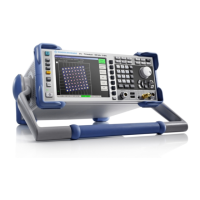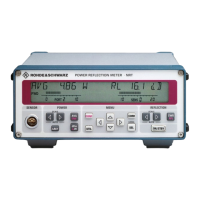Two-port measurements with the tracking generator R&S FSH
1309.6275.12 4.62 E-2
Using the markers in the Smith chart:
Like with the scalar measurement, the Smith chart display also provides all marker functions (marker,
delta marker, multi-marker (see also section "Using the Markers"). The Smith chart also provides
additional marker formats for vector reflection measurements.
Press the MARKER key. The R&S FSH will activate
the marker menu and a marker.
You can shift the marker on the complex reflection
curve by using the rotary knob or the cursor keys,
or by entering numeric values.
The marker values will first be output in numeric format
with the marker frequency and the complex resistance
((real component) + j (imaginary component)) in Z. If
you need to display the complex reflection factor, for
example, you can modify the marker format
accordingly.
Defining the reference impedance
By default, the Smith chart is standardized to an impedance of 50 . In other words, the matching point
in the center of the Smith chart corresponds exactly to 50 . However, reflection measurements using
suitable matching networks and calibration standards can also be carried out in systems with different
impedance values. In this case, the reference impedance for the Smith chart can be modified as
needed.
Press the MARKER MODE key.
Using the rotary knob or the cursor keys, select
REF IMPEDANCE 50 from the menu and
confirm by pressing either the MARKER MODE
softkey or the ENTER key.
The R&S FSH opens a dialog box to enter the
reference impedance. Any value between 1 m and
10 k can be entered.
Defining the reference impedance:
Using the numeric keys, enter the desired
reference impedance and confirm with MARKER
MODE softkey or the ENTER key.

